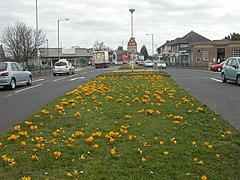Kinson
| Kinson | |
|---|---|
 Wimborne Road, Kinson |
|
| Kinson shown within Dorset | |
| Population | 10,229 |
| OS grid reference | SZ070966 |
| Unitary authority | |
| Ceremonial county | |
| Region | |
| Country | England |
| Sovereign state | United Kingdom |
| Post town | BOURNEMOUTH |
| Postcode district | BH10 and BH11 |
| Dialling code | 01202 |
| Police | Dorset |
| Fire | Dorset and Wiltshire |
| Ambulance | South Western |
| EU Parliament | South West England |
| UK Parliament | |
Kinson is a former village which has been absorbed by the town of Bournemouth in the county of Dorset in England. The area became part of Bournemouth on 1 April 1931. There are two electoral wards containing the name Kinson(North & South). Their joint population at the 2011 Census was 19,824.
The village has a shopping centre and a pub, Gulliver's, known for much of the 19th and 20th centuries as 'The Dolphin', after the boat named Dolphin owned by Isaac Gulliver. Kinson nearly became part of Poole in 1931; however, a vigorous campaign by the residents saw the parish added to Bournemouth instead, necessitating an adjustment to the Hampshire/Dorset county boundary, which had separated the two areas.
The area centres on Kinson village green which is on the Wimborne Road (at this point the A341) next to Kinson Library (now part of The Kinson Hub). The present green, which features a set of , was once the site of the village school. The 1887 Ordnance Survey map for Kinson shows the school, which is now on a site to the south off Kinson Road. By the time of the 1949 survey maps, a library had taken the place of the old school. It was only when the library moved to a new location nearby that the old school/library site was combined with the village pound to form a new village green. A commemorative stone bench was officially unveiled by Mayor Benwell and his wife. The older village green, where cricket matches were played, has now become a development of bungalows, with the name Wicket Road surviving to mark its older use.
Nearby is Kinson Common, a Local Nature Reserve and Site of Special Scientific Interest, and the historic St Andrew's Church, a grade B listed building and the resting place of Frederick Cavendish Ponsonby.
...
Wikipedia

